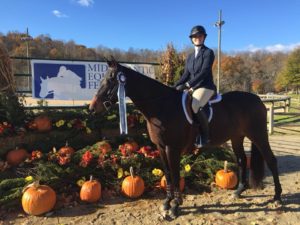I teach riders who are interested in advancing their riding and moving up. Some are adults returning to riding after a long break. Some are riders who have spent a long time in large lesson programs, and have realized they’d like to do more. Whenever a rider wants to move to the next level, invariably there is some amount of fear:
“What if I fall off?”
“What if I embarrass myself?”
“What if I get hurt?”
These are all very normal things to consider. It’s common to have these questions run through your head when riding. As coach, I have to get into a rider’s head, understand their fear and help them get past it. I do this by creating a positive environment, where mistakes are okay, and I make sure the fundamentals are solidified before having a rider take the next step.

Curiously, I frequently witness a tendency in riders to cozy up to their fear, make friends with it, and carry it around with them every step of their ride. Many riders, in an effort to be self-deprecating and non-competitive, join the “Fear Club.” There’s safety in numbers, and everyone wants to talk about it, giving personality and life to their fears. It may feel like your are shedding a burden, but be careful: Fear is contagious.
Have you ever been in a lesson where a rider asks, “How big is that jump?” Sometimes it’s out of sheer curiosity. But other times, there’s an edge of anxiety to the question. Often, I simply state a range, maybe 2’6″ to 2’9″, and move on the instructions for the exercise. But that question gets all of the other riders in the vicinity to start thinking about that particular jump. Is it too high? Will my horse be scared of it? Is the approach easy enough?
There’s nothing wrong with giving voice to fears. Acknowledging one’s concerns and doubts is a good way to overcome them… as long as you are prepared to let them go. Examine them and continue. Make the choice to defeat fear instead of being consumed by it. Steer clear of that “club,” and commit to doing the tough mental work of letting go of fear. Below are some ways to conquer fear and build your confidence.
TIPS FOR OVERCOMING FEAR
Beware of negative phrasing.
Your mind cannot process words like “don’t” and “no.” If you have a problem with looking down at jumps, be sure to phrase your internal instructions in the positive: “Look up,” instead of “Don’t look down.” If you say the latter to yourself, your brain doesn’t recognize “don’t.” Instead, it hears “Look down.” Not the kind of brain training we’re going for, right? Watch out for trainers that talk that way, too. There’s a big difference between saying, “Don’t lean,” and “Bring your shoulders back,” or “Open your hip angle.” Your success depends on coaching that is affirmative, not negative. If you prime your mind for success, there’s less room for fear to seep in.
Surround yourself with the right tribe.
If you want to soar with the eagles, don’t hang out with turkeys. The more you surround yourself with others striving to go beyond, and achieve great things, the more likely your own success becomes. Conversely, if your social group (especially your barn friends) includes people who channel negative thoughts and “joke” about how bad a rider they are, or how scared they were in the last lesson or show, you are likely to feel that way too. Words become actions. Watch what you say, as well as what others say, and who you hang around with.
Enjoy the process.
Love little victories. Success starts with small steps. It’s important to feel like you have mastered the basics before moving on to tougher challenges. I tell students that they should be bored with a certain activity before moving up. If I have a rider who is scared of jumping a two-stride combination, I’ll have them do something with three or four strides before shortening the distance. And I’ll keep the jumps really low for when we are ready to attempt the shorter striding. Learning to ride well can take a long time. As much as we want to press on in the face of fear, moving too quickly to the next steps can stymie progress. Enjoy the process, and take small wins when you can.
Use the power of visualization.
Visualization works! At a show last weekend, I had two students work on visualizing their jumping rounds prior to going into the ring. In the three particular classes they did this extra mental preparation, they had their best courses of the weekend. You have to take the time to be very detailed when you visualize – include the entrance and exit from the ring, as well as your lead changes in the corners. (Ask me how I know that!) It seems fru-fru, but you can train your body to react instinctively when you’ve taken the time to ride the course in your mind beforehand. Try it.

YOUR FEAR IS NOT YOU
Admitting you’re scared is totally normal, especially when dealing with a sport that involves a 1000-pound animal and potential risks. But your fear doesn’t have to own you. Acknowledge your anxieties and commit to becoming the best rider you can be. Finding the right coach is essential to this process. Being open about your goals and making sure you have the necessary tools and resources to accomplish those goals is paramount. Are you putting enough time in? Do you have the right horse? If showing matters to you, are you getting practice showing? (Since that’s an environment that’s impossible to mimic at home.) If the answers to these questions are yes, then your own mental habits (as well as your coach’s) will be your greatest help in getting past any fear that blocks your path.
What are you doing to overcome your nerves and improve your riding? I’d love to hear your thoughts!


Thank you for this! I recently had a nasty fall (all my fault of course!) but it really messed with my head. I have been completely living in my fear but I have a wonderful trainer! I knew she was wonderful before but I never thought about how she speaks in lessons. I realize that the only time I hear “don’t” out of her mouth it is to (lately) tell me “don’t second guess your spots.” Everything else is always stated in the positive action phrase. One of my barn mates mentioned visualization to me and I am going to try that this weekend at my first show with my new guy who is EXTREMELY skiddish so I need to stay as calm as possible. This was a very long comment just to say thanks for your post. Lol
Thanks, Rachel! I really believe in positive visualization. It’s worked wonders for several of our riders.